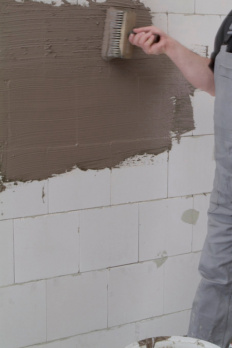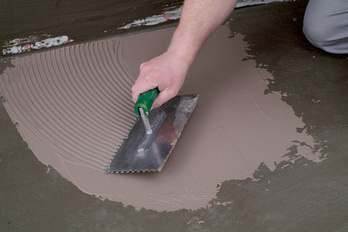For detailed information, other images and documents, please select individual articles from the following table.
2-C slurry-type seal coating CERAfix® 301
Flexible crack-bridging, mineral two-component sealing slurry for indoor and outdoor use
Register now and access more than 125,000 products





Variants
Certified quality
- General test certificate from construction authorities
- Classification of fire behaviour in accordance with EN 13501-1 and EN ISO 11925-2
- Tested for water impermeability in line with DIN 4030
Particularly high degree of flexibility
- Very suitable for bridging cracks
- Secure even on surfaces exposed to cracking or considerable movement
Water vapour permeable
Ideal for slightly damp surfaces
High bond adhesion without priming
Perfect for use as a seal in conjunction with tile coverings, including in vertical areas
Resistant to thawing/freezing alternations
- Suitable for indoor and outdoor use
- Can be used in wet rooms and swimming pools exposed to high stresses and on balconies and terraces
Our products featuring the EMICODE label are low emission/environmentally compatible. The EMICODE classification system awards labels to construction products that comply with the very stringent health and environmental requirements of recognised institutes.
P-DD 4863/1/2008 Bautest Dresden
Tested in accordance with EN 14891
- Initial adhesion strength: ≥ 0.5 N/mm²
- Adhesive tensile strength on contact with water: ≥ 0.5 N/mm²
- Adhesive tensile strength after thermal ageing: ≥ 0.5 N/mm²
- Adhesive tensile strength after alternating freezing/thawing stress: ≥ 0.5 N/mm²
- Adhesive tensile strength on contact with lime water: ≥ 0.5 N/mm²
- Impermeable to water: No penetration of water
- Crack bridging: ≥ 0.75 mm
Classification of fire behaviour in accordance with EN 13501-1 and EN ISO 11925-2
Tested for water impermeability in line with DIN 4030
EMICODE EC1plus: Very low emissions: The EMICODE classification system distinguishes the environmental and health compatibility of construction products. The lowest-emission products bear the EC1plus mark.
- Protect surfaces that do not require treatment against exposure to CERAfix 301!
- During the bonding process, the seal must not be exposed to water. If water gets behind the material, it can lead to spalling in the event of frost.
- In case of strong sunlight, work in shaded areas with your back to the sun.
- In spaces with high humidity and/or insufficient ventilation (e.g. water tanks), the surface may drop below dew point (condensation formation). This can be eliminated by suitable means, such as condensation dryers. Direct heating or uncontrolled blowing of hot air is not permitted
- CERAfix 301 must not be subjected to point or linear loads when used a surface coating.
- CERAfix 301 can be plastered over or covered with diffusion-open, solvent-free dispersion façade or dispersion silicate paints (not pure silicate paints). Silicone resin paints and acrylate-based paints can also be used.
- Direct contact with metals, such as copper, zinc and aluminium, must be prevented by means of a pore-tight primer. Two coats of CERAfix 103 are applied to produce a pore-tight primer. The first coat is applied liberally to the degreased and cleaned substrate. Once this layer has begun to react such that it can no longer be spread through (approx. 3-6 hours*), a further CERAfix 103 layer is applied and scattered with TEGAfix 430 quartz sand. Consumption approx. 800-1,000 g/m2 of CERAfix 103.
- Currently applicable regulations must be observed! Observe the applicable EC safety data sheet!


| Material requirements: | |||
| Possible additional consumption in the case of uneven surfaces as well as variations in workmanship must be taken into account. | |||
| Effect of action | Dry layer thickness, mm | Wet layer thickness, mm | Consumption kg/m² |
| According to WTA leaflet 4-6 "Subsequent sealing of components in contact with the ground" | |||
| Non-pressurised water | >2.0 | Approx. 2.2 | 3,5 |
| Accumulating seepage water/pressurised water | >3.0 | Approx. 3.3 | 5,3 |
| Sealing of basins and containers | >2.0 | Approx. 2.2 | 3,5 |
| In a compound structure with tiles and panels | >2.0 | Approx. 2.2 | 3,5 |
| Levelling layers | 1 mm | 1.1 mm | 1,75 |
| Basement walls and floor panels | >2.0 | Approx. 2.2 mm | 3,5 |
| Base seal | >2.0 | Approx. 2.2 | 3,5 |
| Cross-section seal | >2.0 | Approx. 2.2 | 3,5 |
| Soil moisture/non-accumulating seepage water | >2.0 | Approx. 2.2 | 3,5 |
P-DD 4863/1/2008 Bautest Dresden
Tested in accordance with EN 14891
- Initial adhesion strength: ≥ 0.5 N/mm²
- Adhesive tensile strength on contact with water: ≥ 0.5 N/mm²
- Adhesive tensile strength after thermal ageing: ≥ 0.5 N/mm²
- Adhesive tensile strength after alternating freezing/thawing stress: ≥ 0.5 N/mm²
- Adhesive tensile strength on contact with lime water: ≥ 0.5 N/mm²
- Impermeable to water: No penetration of water
- Crack bridging: ≥ 0.75 mm
Classification of fire behaviour in accordance with EN 13501-1 and EN ISO 11925-2
Tested for water impermeability in line with DIN 4030
EMICODE EC1plus: Very low emissions: The EMICODE classification system distinguishes the environmental and health compatibility of construction products. The lowest-emission products bear the EC1plus mark.
The usage instructions are recommendations based on the tests we have conducted and our experience; carry out your own tests before each application. Due to the large number of applications and storage and processing conditions, we do not assume any liability for a specific application result. Insofar as our free customer service provides technical information or acts as an advisory service, no responsibility is assumed by this service except where the advice or information given falls within the scope of our specified, contractually agreed service or the advisor was acting deliberately. We guarantee consistent quality of our products. We reserve the right to make technical changes and further develop products.
Product residues can be disposed of in accordance with waste codes AVV 17 01 01 and AVV 08 04 10.
For quick, seamless sealing under tiles and panels for indoor and outdoor use, e.g. in bathrooms, showers, private and public toilets, as well as balconies and terraces, swimming pools and basin perimeters. In accordance with the Central Federation of the German Building Trade's technical information leaflet, CERAfix 301 is suitable for moisture resistance classes A0 and B0. Also suitable for class A and B in accordance with test criteria for general construction approval.
Pour approx. 50-70% of the liquid B component into the mixing bucket. Add the powder A component to this and mix until there are no clumps. Between applications, use a trowel to scrape along the walls of the mixing container to add adhesive, unmixed material to the mixing process. Then mix in the rest of the liquid B component. The use of a Würth agitator running at approx. 500-750 rpm is recommended. Apply the mixed compound evenly with a suitable tool in at least 2 layers, aiming for a layer thickness of 2 mm across the fill width. Exclude an application thickness of more than 2 kg/m2 in one pass - otherwise cracks in the sealing layer (particularly with air movement and/or heat) may occur due to the high bonding agent content. Subsequent work operations can be carried out once the first layer can no long be damaged by being walked on or used.
Select RAL-colour code
!! NOTE: On-screen visualisation of the colour differs from real colour shade!!










